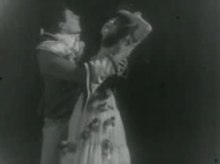Danse macabre (Saint-Saëns)
Danse macabre, Op. 40, is a tone poem for orchestra, written in 1874 by the French composer Camille Saint-Saëns. It premiered 24 January 1875. It is in the key of G minor. It started out in 1872 as an art song for voice and piano with a French text by the poet Henri Cazalis, which is based on an old French superstition.[1] In 1874, the composer expanded and reworked the piece into a tone poem, replacing the vocal line with a solo violin part.
Analysis[]
According to legend, Death appears at midnight every year on Halloween. Death calls forth the dead from their graves to dance for him while he plays his fiddle (here represented by a solo violin). His skeletons dance for him until the rooster crows at dawn, when they must return to their graves until the next year.
The piece opens with a harp playing a single note, D, twelve times (the twelve strokes of midnight) which is accompanied by soft chords from the string section. The solo violin enters playing the tritone, which was known as the diabolus in musica ("the Devil in music") during the Medieval and Baroque eras, consisting of an A and an E♭—in an example of scordatura tuning, the violinist's E string has actually been tuned down to an E♭ to create the dissonant tritone.
The first theme is heard on a solo flute,[2] followed by the second theme, a descending scale on the solo violin which is accompanied by soft chords from the string section.[3] The first and second themes, or fragments of them, are then heard throughout the various sections of the orchestra. The piece becomes more energetic and at its midpoint, right after a contrapuntal section based on the second theme,[4] there is a direct quote[5] played by the woodwinds of Dies irae, a Gregorian chant from the Requiem that is melodically related to the work's second theme. The Dies irae is presented unusually in a major key. After this section the piece returns to the first and second themes and climaxes with the full orchestra playing very strong dynamics. Then there is an abrupt break in the texture[6] and the coda represents the dawn breaking (a cockerel's crow, played by the oboe) and the skeletons returning to their graves.
The piece makes particular use of the xylophone to imitate the sounds of rattling bones. Saint-Saëns uses a similar motif in the Fossils movement of The Carnival of the Animals.
The progression and melody of the minor waltz are similar to the jibes (e.g. "their sweethearts all are dead") of the Sailors' Chorus in "Helmsman/Steersman, Leave Your Watch," which begins the third act of Wagner's earlier opera, "The Flying Dutchman".
Instrumentation[]
Danse macabre is scored for an obbligato violin and an orchestra consisting of one piccolo, two flutes, two oboes, two clarinets in B♭, two bassoons; four horns in G and D, two trumpets in D, three trombones, one tuba; a percussion section that includes timpani, xylophone, bass drum, cymbals and triangle; one harp and strings.
Reception[]
When Danse macabre was first performed on January 24, 1875 it was not well received and caused widespread feelings of anxiety. The 21st century scholar, Roger Nichols, mentions adverse reaction to "the deformed Dies irae plainsong", the "horrible screeching from solo violin", the use of a xylophone, and "the hypnotic repetitions", in which Nichols hears a pre-echo of Ravel's Boléro.[7]
Today, it is considered one of Saint-Saëns' masterpieces, widely regarded and reproduced in both high and popular culture.
Transcriptions[]
Shortly after the premiere, the piece was transcribed into a piano solo arrangement by Franz Liszt (S.555),[8] a good friend of Saint-Saëns. Next to countless other piano solo transcriptions, Ernest Guiraud wrote a version for piano four hands and Saint-Saëns himself wrote a version for two pianos, and in 1877 also a version for violin and piano. In 1942, Vladimir Horowitz made extensive changes to the Liszt transcription. This version is played most often today.
There is an arrangement for Pierrot ensemble (flute, clarinet, violin, cello, piano) by Tim Mulleman, and an organ transcription by Edwin Lemare.
Usage[]
- The piece was later used in dance performances, including those of Anna Pavlova.[9]
- An adaptation of the piece is used as the theme music for Jonathan Creek, a mystery crime series on British television.[10]
References[]
- ^ Boyd, Malcolm. "Dance of death", Grove Music Online, Oxford University Press, retrieved 6 October 2015. (subscription required)
- ^ [IMSLP full score, page 3]
- ^ [full score, page 4, 4th bar]
- ^ [full score, page 13, rehearsal letter C]
- ^ [full score, page 16, rehearsal letter D]
- ^ [full score, page 50, 6th bar]
- ^ Nichols, Roger (2012), Notes to Chandos CD CHSA 5104, OCLC 794163802
- ^ Salle, Michael (2004). Franz Liszt: A Guide to Research. New York: Routledge. p. 460. ISBN 0-415-94011-7.
- ^ Garafola, Lynn (2005). Legacies of Twentieth-century Dance. New York: Wesleyan University Press. pp. 155–156. ISBN 978-0-8195-6674-4.
- ^ "A Danse Macabre". Classicfm.com. Retrieved 3 February 2018.
External links[]
- 1874 compositions
- Compositions by Camille Saint-Saëns
- Compositions in G minor
- Death in music
- Halloween compositions
- Music based on art
- Music based on European myths and legends
- Music based on poems
- Music with dedications
- Symphonic poems
- The Devil in classical music


